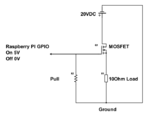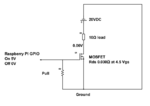onklen
Newbie level 3
I'm working on a small project where I want to use my Raspberry PI to turn on/off a power resistor for temperature control. I'm looking at a maximum of 50W and I have a 24VDC power supply so I will be looking at approximately 2A through the power resistor.
Would this design be best by using a MOSFET to activate a 24VDC relay or would it be fine to simply use a MOSFET that would be rated for 2A and skip out on the relay?
I'm hoping that I can drive it directly from the Raspberry PI so naturally the gate current would need to be kept low as well as the gate voltage as I won't have more than 5V.
Any good advices on a specific MOSFET that might be handy?
Regards,
Rolf
Would this design be best by using a MOSFET to activate a 24VDC relay or would it be fine to simply use a MOSFET that would be rated for 2A and skip out on the relay?
I'm hoping that I can drive it directly from the Raspberry PI so naturally the gate current would need to be kept low as well as the gate voltage as I won't have more than 5V.
Any good advices on a specific MOSFET that might be handy?
Regards,
Rolf

